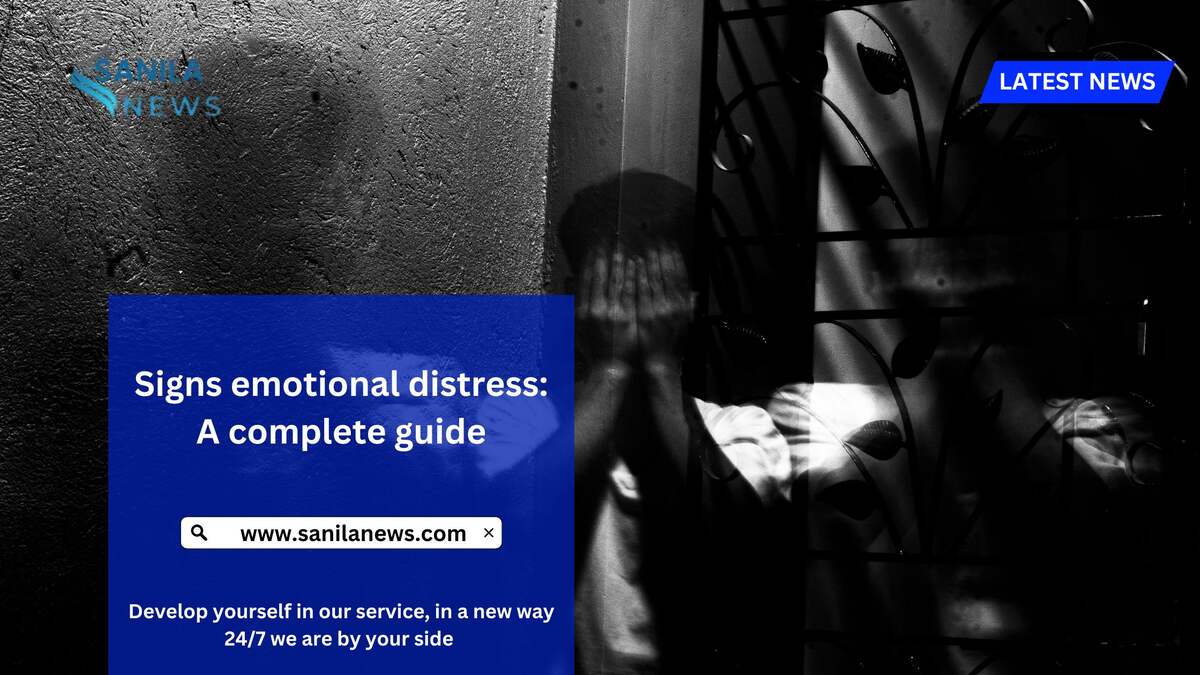Signs of Emotional Distress
Emotional distress is a state of mental suffering or anguish that can arise from various life circumstances. Whether triggered by significant life changes, traumatic events, ongoing stress, or interpersonal conflicts, emotional distress can profoundly impact a person’s overall well-being. Recognizing the signs of emotional distress is crucial for addressing it promptly and seeking appropriate support. In this article, we will explore the common signs of emotional distress, their potential causes, and how to navigate these challenges toward emotional healing and stability.
1. Signs emotional distress Changes in Mood
One of the most apparent signs of emotional distress is a noticeable shift in mood. This can include:
- Irritability: A person may become easily frustrated, annoyed, or angered by situations that would not typically trigger such a reaction.
- Sadness or Depression: Feelings of overwhelming sadness, hopelessness, or worthlessness are common indicators of emotional distress. Individuals may struggle to find joy in activities they once enjoyed.
- Mood Swings: Rapid changes in mood, from happiness to sadness or irritability, can signal underlying emotional turmoil.
These mood changes may seem out of character and can be disruptive to daily life and relationships.
2. Social Withdrawal
Signs emotional distress People experiencing emotional distress often isolate themselves from friends, family, and social activities. This withdrawal may manifest as:
- Avoiding social gatherings or canceling plans frequently.
- Reduced communication with loved ones.
- A general lack of interest in connecting with others.
This behavior is typically a coping mechanism to deal with emotional overwhelm. Individuals may feel emotionally drained or unable to engage in social interactions.
3. Changes in Sleep Patterns
Emotional distress can significantly impact sleep. Sleep disturbances may include:
- Insomnia: Trouble falling asleep, staying asleep, or waking up frequently during the night.
- Oversleeping: Sleeping for extended periods or taking frequent naps during the day as a way to escape emotional pain.
- Nightmares or Restless Sleep: Individuals may experience nightmares or disruptive, restless sleep that leaves them feeling fatigued upon waking.
Disrupted sleep patterns can exacerbate emotional distress, creating a cycle of sleeplessness and heightened emotional sensitivity.
4. Appetite Changes
A person’s appetite may change dramatically when they are emotionally distressed. These changes can vary widely:
- Loss of Appetite: Stress, anxiety, and depression may cause some individuals to lose interest in eating, leading to unintended weight loss and malnutrition.
- Overeating or Emotional Eating: Others may turn to food as a source of comfort, leading to overeating or binge eating, which can result in weight gain and health complications.
Both extremes of appetite changes are warning signs that emotional distress is affecting physical health.
5. Physical Symptoms
Emotional distress can also manifest in physical symptoms, even when there is no direct physical cause. Some common physical indicators include:
- Headaches: Tension headaches or migraines are often associated with prolonged emotional distress.
- Digestive Issues: Stomachaches, nausea, diarrhea, or constipation can result from stress and emotional strain.
- Fatigue: Constant emotional turmoil can be exhausting, leading to a persistent feeling of tiredness, even with sufficient rest.
- Muscle Tension: Chronic stress can cause muscle tension, particularly in the neck, shoulders, and back.
These physical symptoms should not be ignored, as they can be signs that the body is responding to emotional challenges.
6. Difficulty Concentrating
Emotional distress can make it difficult for individuals to focus or concentrate on tasks. This cognitive impairment may present as:
- Trouble remembering things or retaining information.
- Difficulty making decisions or solving problems.
- An inability to stay engaged in work or academic tasks.
This lack of focus can lead to decreased productivity and a sense of frustration or inadequacy, further exacerbating emotional struggles.
7. Substance Use
Signs emotional distress Many people turn to substances such as alcohol, drugs, or prescription medications to cope with emotional distress. Increased substance use can be a dangerous coping mechanism that may temporarily numb emotional pain but ultimately worsens the situation. Some warning signs of substance misuse include:
- Drinking alcohol more frequently or in larger quantities than usual.
- Using drugs or other substances to escape feelings of sadness, anxiety, or fear.
- Relying on prescription medications, such as sedatives or stimulants, to cope with emotions.
Substance use can quickly become a destructive cycle, leading to addiction, health problems, and further emotional distress.
8. Increased Anxiety
Heightened anxiety is a common response to emotional distress. Symptoms of anxiety may include:
- Racing Thoughts: Constantly worrying about future events or replaying past experiences.
- Restlessness: Feeling on edge or unable to relax, even in calm environments.
- Physical Symptoms of Anxiety: Sweating, trembling, rapid heart rate, and shortness of breath.
Anxiety can be paralyzing, preventing individuals from enjoying life or completing routine tasks. It can also lead to panic attacks, characterized by intense fear and physical symptoms such as chest pain and dizziness.

9. Increased Sensitivity to Rejection or Criticism
People experiencing emotional distress may become overly sensitive to rejection, criticism, or perceived slights. This heightened sensitivity can manifest in the following ways:
- Overreacting to Minor Criticism: Feeling deeply hurt by feedback or comments that are relatively mild or constructive.
- Fear of Abandonment: Constantly worrying that loved ones will leave or reject them.
- Seeking Reassurance: Frequently seeking validation or reassurance from others to soothe feelings of insecurity.
This sensitivity can strain relationships and lead to a cycle of self-doubt and low self-esteem.
10. Self-Harm or Suicidal Thoughts
In severe cases of emotional distress, individuals may resort to self-harm or have thoughts of suicide. These are serious signs that require immediate attention and support. Self-harm may include:
- Cutting or scratching the skin.
- Hitting oneself or engaging in other forms of self-inflicted physical harm.
- Engaging in reckless or dangerous behaviors as a form of self-punishment.
Suicidal thoughts or actions are a critical warning sign that someone is overwhelmed by emotional pain. If you or someone you know is experiencing these thoughts, it is vital to seek professional help immediately by contacting a mental health professional or emergency services.
11. Feelings of Hopelessness or Worthlessness
A pervasive sense of hopelessness or worthlessness can develop during emotional distress. Individuals may feel as though nothing will ever improve or that they have no value. These feelings may manifest in statements like:
- “What’s the point of trying?”
- “I’m not good enough.”
- “Things will never get better.”
This mindset can lead to a downward spiral, where the individual withdraws from positive activities and support systems that could help alleviate their distress.
12. Crying Spells or Emotional Outbursts
Frequent crying spells, often without a clear cause, are another indicator of emotional distress. These episodes may occur in private or in public settings, and the person may feel embarrassed or ashamed afterward. In contrast, emotional outbursts, such as anger or frustration, may also occur. These outbursts may seem disproportionate to the situation and can strain relationships or create conflict in personal and professional environments.
13. Loss of Interest in Hobbies and Activities
A person in emotional distress may lose interest in hobbies, passions, or activities they once enjoyed. This symptom, often associated with depression, can result in:
- Disengagement: A lack of motivation to participate in leisure activities, sports, or creative pursuits.
- Withdrawal from Social or Recreational Groups: A person may stop attending social clubs, sports leagues, or gatherings they previously enjoyed.
This loss of interest can further isolate the individual, depriving them of opportunities to experience positive emotions and connect with others.
14. Difficulty Managing Daily Responsibilities
Emotional distress can impair a person’s ability to manage daily responsibilities effectively. Signs of this may include:
- Missing work or school due to overwhelming emotions.
- Falling behind on chores, bills, or personal care.
- Struggling to meet the needs of family members, children, or pets.
This difficulty in managing daily tasks can exacerbate feelings of inadequacy and stress, creating a cycle of emotional turmoil.
15. Loss of Confidence or Self-Esteem
During periods of emotional distress, an individual’s confidence or self-esteem may take a hit. They may feel incapable of handling life’s challenges and may doubt their abilities in personal or professional roles. Signs of low self-esteem include:
- Negative self-talk: Frequently putting oneself down or believing they are not worthy of success or happiness.
- Avoiding new challenges or opportunities due to fear of failure.
- Comparing oneself negatively to others, further diminishing self-worth.
Conclusion
Emotional distress can manifest in various ways, affecting an individual’s mood, physical health, behavior, and overall well-being. Recognizing the signs of emotional distress is the first step toward seeking help and embarking on the path to healing. If you or someone you know is exhibiting any of the signs mentioned above, it is essential to reach out to a trusted friend, family member, or mental health professional for support. Remember, emotional distress is a normal response to challenging life events, but it doesn’t have to be endured alone. With the right resources and support, it is possible to overcome emotional distress and regain emotional stability and resilience.
Read More:

